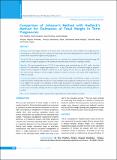Please use this identifier to cite or link to this item:
https://hdl.handle.net/20.500.14356/1391Full metadata record
| DC Field | Value | Language |
|---|---|---|
| dc.contributor.author | Pradhan, Peru | - |
| dc.contributor.author | Neupane, Binita | - |
| dc.contributor.author | Shrestha, Sona | - |
| dc.contributor.author | Dangal, Ganesh | - |
| dc.date.accessioned | 2023-05-09T10:36:51Z | - |
| dc.date.available | 2023-05-09T10:36:51Z | - |
| dc.date.issued | 2019 | - |
| dc.identifier.citation | PradhanP., NeupaneB., ShresthaS., & DangalG. (2019). Comparison of Johnson’s Method with Hadlock’s Method for Estimation of Fetal Weight in Term Pregnancies. Journal of Nepal Health Research Council, 17(2), 228-232. https://doi.org/10.33314/jnhrc.v0i0.1999 | en_US |
| dc.identifier.issn | Print ISSN: 1727-5482; Online ISSN: 1999-6217 | - |
| dc.identifier.uri | http://103.69.126.140:8080/handle/20.500.14356/1391 | - |
| dc.description | Original Article | en_US |
| dc.description.abstract | Abstract Background: Fetal weight estimation is of utmost need to determine the course of labour and complications for its management. This study intents to compare the fetal weight determined through Johnson’s method and Hadlock’s method with actual birth weight in term pregnancies. Methods: This is an observational study carried out over a period of six months in Kirtipur Hospital among 200 samples of term, singleton pregnancy with cephalic presentation using convenience sampling technique. Results: The mean maternal age was 25.9±4.3 years whereas mean gestational age was 39.1 weeks. Less than half (49.1%) of the babies’ weight ranged between 3.0 - 3.5 kgs. The mean error of estimated weight by Johnson’s method was less compared to Hadlock’s method 185.1±191.1 grams and 355.8±225.7 grams respectively. It was also observed that estimation of fetal weight by Johnson’s method was closer to the actual birth weight than by Hadlock’s method. Conclusions: Johnson’s method requires some basic skills and knowledge with flexibility to apply as and where needed beyond the health facilities irrespective of the availability of the equipment. Furthermore, it was also observed to be slightly more specific in its estimation of birth weight among the term pregnancies compared to Hadlock’s method. Hence, it should be promoted widely among the clinicians. However, Hadlock’s method is equally important for detection of anomalies and high-risk factors coupled with confirmation of the estimation made through Johnson’s method. Keywords: Actual birth weight; estimated fetal weight; hadlock’s method; johnson’s method. | en_US |
| dc.language.iso | en | en_US |
| dc.publisher | Nepal Health Research Council | en_US |
| dc.relation.ispartofseries | Apr-June, 2019;1999 | - |
| dc.subject | Actual birth weight | en_US |
| dc.subject | Estimated fetal weight | en_US |
| dc.subject | Hadlock’s method | en_US |
| dc.subject | Johnson’s method | en_US |
| dc.title | Comparison of Johnson’s Method with Hadlock’s Method for Estimation of Fetal Weight in Term Pregnancies | en_US |
| dc.type | Journal Article | en_US |
| local.journal.category | Original Article | - |
| Appears in Collections: | Vol. 17 No. 2 Issue 43 Apr - Jun 2019 | |
Files in This Item:
| File | Description | Size | Format | |
|---|---|---|---|---|
| 1999-Manuscript-10750-2-10-20190805.pdf | Fulltext Download | 324.72 kB | Adobe PDF |  View/Open |
Items in DSpace are protected by copyright, with all rights reserved, unless otherwise indicated.
